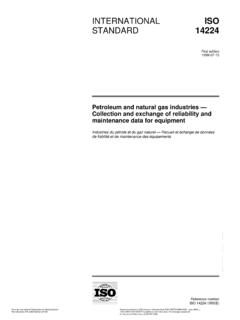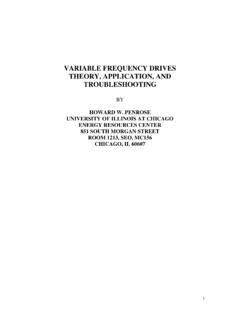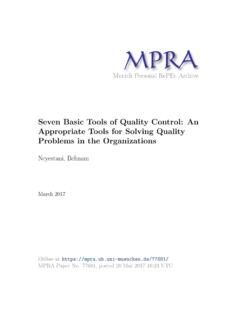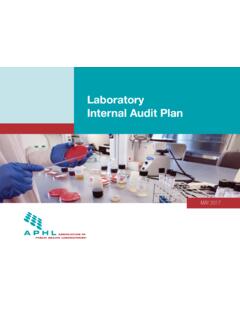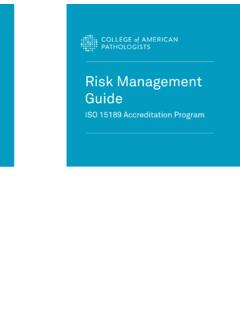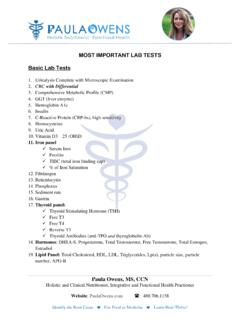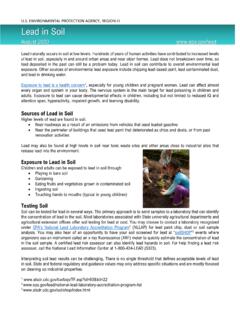Transcription of Vibration acceptance criteria - Maintenance
1 Vibration EFFECTS. Vibration acceptance criteria By Adam Mayers, mechanical engineer, Aspec Engineering The effects of vibrating loads on structures can often be significantly greater than the effects of static loads of equal or greater magnitude. T hese effects can include, among others, fatigue damage such as cracking and breakage, damage to operating equipment due to excessive ambient Vibration and human discomfort. These guidelines are very useful as a first pass to de- termine the suitability of Vibration levels. Where there are significant structural integrity concerns however, a detailed Traditionally, structures subjected to dynamic loads have Vibration and fatigue analysis , often using finite element been designed by trying to ensure that the major natural fre- methods (FEA), may be required.
2 Again, this analysis should quencies of the structure are not close to the frequency of the consider the full response of the structure to the applied vi- applied forces. While the calculation and study of the structure's bration forces, and the resulting loads and stresses developed natural frequencies presents a guide to the behaviour of the in the structure. structure, it does not give the complete picture. Generally, the overall response of the structure to applied Equipments serviceability Vibration forces should be determined and compared to defined High levels of Vibration can adversely affect the life of operat- acceptance criteria .
3 Similarly, where Vibration may be causing ing equipment and can increase the frequency of breakdowns, problems on existing structures, the overall response should be leading to excessive Maintenance . A great deal of work is often measured with appropriate equipment and compared to accept- conducted to measure the balance and Vibration of individual ance criteria . pieces of equipment, but often the level of ambient Vibration This article outlines the details of the codes/standards defin- transmitted through the supporting structure can have a signifi- ing the acceptance criteria for Vibration , particularly for vibra- cant effect on the life of equipment.
4 Tion of industrial structures. Equipment manufacturers may provide information on acceptable levels of ambient Vibration ; however, where this Structural integrity information is not available, and provide The German standard DIN 4150 Part 3 provides Vibration veloc- guidelines for evaluating the effect of ambient Vibration on the ity guidelines for use in evaluating the effect of Vibration on life of equipment. structural integrity (see Table 1). Depending on the class of the equipment (for example, The guideline limits presented in the standard are based on small, medium, large etc), AS2625 defines RMS Vibration experience, and are defined as safe limits' up to which no dam- velocity limits corresponding to different qualitative evalua- age due to Vibration effects has been observed for a particular tion zones (see Figure 1).
5 The four zones are defined in the class of building. Damage is defined by DIN4150 to included standard as: even minor non-structural damage. For continuous long-term Good (Zone A): The Vibration of newly commissioned ma- Vibration , 10 mm/s peak Vibration velocity is seen as a safe limit chines would normally fall within this zone. for structural integrity in industrial buildings. Allowable (Zone B): Machines with Vibration within this zone Although these limits are defined in the code as being for are normally considered acceptable for unrestricted long-term Vibration in the horizontal direction at the top floor of a build- operation.
6 Ing, ASPEC's experience with Vibration studies at a number of Just tolerable (Zone C): Machines with Vibration within this Australian industrial plants has shown that these limits are effec- zone are normally considered unsatisfactory for long-term tive for local Vibration levels as well. Structural damage has been continuous operation. Generally, the machine may be oper- observed on members where the Vibration velocity exceeds ated for a limited period in this condition until a suitable approx 20-40 mm/s. opportunity arises for remedial action.
7 Not permissible (Zone D): Vibration values within this zone Guideline values for are normally considered to be of sufficient severity to cause velocity in mm/s, of damage to the machine. Type of Structure Vibration in horizontal plane of highest floor, at These guidelines are especially useful where sensitive equipment is all frequencies required to operate in the vicinity of highly vibrating equipment. Buildings used for commercial 1 purposes, industrial buildings, 10. and buildings of similar design Dwellings and buildings of simi- 2 5.
8 Lar design and/or occupancy Structures that, because of their particular sensitivity to vibra- tion, cannot be classified under 3 lines 1 and 2 and are of great intrinsic value ( listed build- ings under preservation order). Table 1: Safe limits for structural integrity for long-term continuous Vibration (DIN4150). Figure 1: Machine Vibration criterion chart (AS2625). 54 Australian Bulk Handling Review: March/April 2009. Vibration EFFECTS. Human body perception and response Comparison of acceptance levels The human body can detect magnitudes of Vibration lower than To compare the acceptance levels for the discussed criteria , those which would normally cause mechanical or structural typical acceptance levels for an industrial building vibrating problems.
9 The discomfort or annoyance produced by whole at 20 Hz (1200 RPM) are summarised in Table 3 below. As can body Vibration is a very influential factor and may be one of the be seen in the table, there can be significant differences in the limiting parameters in the design of the structure. acceptable level of Vibration depending on the issue of concern. Data on human exposure to Vibration has been incorporated For instance, significantly higher levels of Vibration can often be into AS2670: Evaluation of human exposure to whole-body vibra- tolerated in areas of a building that are unoccupied, or do not tion.
10 Vibration exposure limits are given as a function of: house operating equipment. Direction of motion, either horizontal or vertical. Frequency of Vibration . Acceleration of the oscillations. Equivalent criteria & RMS or Acceptable Exposure time. Acceleration at Relevant Standard Peak? Limit at 20 Hz 20 Hz (m/s2). The method prescribed in for Vibration between 1 and 80 Hz is to compare the magnitude of RMS Vibration (accelera- tion) to established base curve levels which are approximately Structural Integ- Peak 10 mm/s m/s2. equal to a level of significant human annoyance and/or com- rity (DIN4150).




